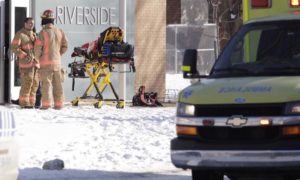‘Let’s not have another tragedy. Let’s get it done’
Posted on 14.01.2019 in the General category
A week after dozens of Montreal children suffered carbon monoxide poisoning at school, the province has admitted not all New Brunswick schools have detectors – and it’s not sure which ones do.
The Department of Transportation and Infrastructure confirmed this week the province has no written policy requiring schools to have carbon monoxide alarms, even though it said 130 of the province’s schools burn fuel that could emit carbon monoxide.
Four business days after the Daily Gleaner requested information, the department says it is “taking steps” to place the potentially life-saving devices in schools, though department spokesperson Jeremy Trevors said in an email to the Daily Gleaner: “At this time, we do not have an accurate count of which schools have devices installed and which ones do not.”
Trevors did not respond to a question asking how many of the 130 fuel-burning schools have carbon monoxide detectors.
High levels of carbon monoxide at a Montreal elementary school resulted in the hospitalization of at least 43 people – most of them children – on Jan. 14. The incident prompted the Quebec government to announce carbon monoxide detectors will become mandatory in all schools.
John Gignac, a retired Ontario firefighter whose niece, her husband and their two children died from carbon monoxide poisoning in 2008, said the Montreal incident serves as a wake-up call: schools need alarms.
“I just think it’s absolutely unbelievable,” Gignac said. “If my child was in that school, I would be kicking up a major fuss.”
He is calling on New Brunswick to make it law for all schools – regardless of whether or not they burn fuel – to install carbon monoxide alarms, preventing future near-misses or tragedies.
“We have to have somebody suffer, like these children, or somebody die, before we pay attention,” Gignac said, noting even if a school doesn’t burn fuel, people could be at risk of carbon monoxide poisoning if, for instance, a generator is running inside. “Let’s not have another tragedy. Let’s get it done before that happens.”
In his email, Trevors said the department is confident New Brunswick school children are not at risk, as the province conducts regular inspections.
“That being said, we want to ensure our schools are as safe as possible for our students and that is why we are taking steps to ensure that all schools with fuel-fired appliances have monitoring devices.”
He said some schools built in the last year or two would have carbon monoxide alarms in kitchens.
“DTI is currently working with the Department of Education and Early Childhood Development to assess and determine where we already have them and where they are required with a goal to have monitors installed in every school that has fuel-fired appliances,” he said. “The remaining schools in the province that do not have fuel-fired appliances do not need monitoring devices as there would be no appliance emitting carbon monoxide.”
The Gleaner reached out to all school districts to ask if they have carbon monoxide detectors in schools.
Anglophone North directed requests for information to the Department of Transportation. Francophone Northeast said none of its 34 schools have carbon monoxide detectors. Francophone South said 10 of its 37 schools – those that use gas for heating or cooking – have carbon monoxide detectors.
The other districts didn’t respond.
The province stepped up its repeated warnings to residents about the dangers of carbon monoxide dangers and the need for detectors in homes after two people died from carbon monoxide poisoning during the 2017 ice storm.
In November, a Fredericton family of four was hospitalized for carbon monoxide poisoning after they brought a generator inside their garage during a power outage.
Carbon monoxide is odourless, colourless and tasteless. Symptoms can include loss of consciousness, vomiting, dizziness and blurred vision.
Gignac said schools need to take action, just as they did after school shootings became an issue in North America.
“We started doing lockdowns. We started locking the doors to protect our children,” he said. “But yet, a simple task of putting a CO alarm in the schools to alert them about the dangers and they’re not doing it.”
In the Montreal case, officials determined the high levels of carbon monoxide were the result of a faulty heating system, according to Postmedia reports.
Gignac said he’ll never stop pushing governments to do more when it comes to potentially saving lives.
“It just infuriates me that I still am out here pounding the streets, trying to get these people to listen,” he said. “Carbon monoxide’s so easy to get protected from. But we’re not doing it.”
Education Minister Dominic Cardy was not available for an interview Wednesday.
—
Katrina Clarke
Reporter | The Daily Gleaner
Photo Credit: High levels of carbon monoxide at École des Decouvreurs in Montreal resulted in the hospitalization of at least 43 people – most of them children – on Jan. 14.
Photo: Allen McInnis/Montreal Gazette

